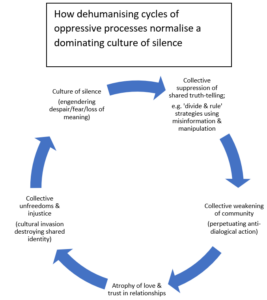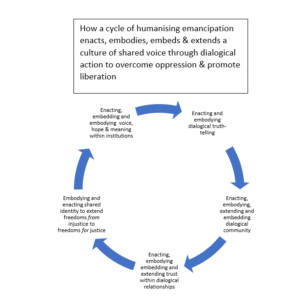Bill Walker
This is the third post in a three-part series on the pedagogy and praxis of Paulo Freire.
Reinventing Freire for the twenty-first century
In our changing world, is Freire’s democratising approach to countering institutionalised oppression still relevant?
My second blog outlined how Freire’s twentieth-century democratising praxis arose from large-scale experimentation in colonised, authoritarian and collectivist cultures, still common across ‘’the Global South.’ Despite changed historical settings since Freire’s experimentation, much contemporary evidence supports key aspects of his analysis and approach in a variety of oppressive contexts, when reinvented. In this blog, I outline the story of how communities have, for over eight decades, been reinventing Freirean praxis by translating, embedding, and extending it from the grassroots ‘up.’
Translating and embedding Freire’s historical praxis into contemporary contexts
By instilling in oppressed persons an acceptance of their inferiority, oppressive institutional systems stymy people’s belief in their identity and capabilities, individually and collectively. Robbing them of what they collectively know dehumanises them, causing them to doubt their shared identities, moral convictions about injustice, and animating emotions arising from suffering injustice and the shared self-efficacy needed to sustain struggles. Dehumanisation is thus parasitic on the very kinds of ‘knowing’ necessary to translate motivation into collective democratic action1 . By attacking what motivates struggles, oppressors embed and normalise oppression.
Starting in North-East Brazil Freire showed how, through shared knowing learning and action, oppressed people can emancipate each other from oppression. Thousands of subordinated people embedded in colonised cultures rapidly became literate and politically effective citizenries. So effective was Freire’s praxis that Brazil’s military regime imprisoned, and then exiled him because his approach threatened its normalising of oppression.
By harnessing the power of their own cultural institutions, countless other such citizenries have since been able to name and transform unjust institutions. Dialogue questioning the status quo facilitates more equitable and just relationships because it socially enforces more transparent and accountable relationships. Freire calls such socio-culturally enforceable dialogue ‘dialogical action.’ Voice embodied within such dialogue is cultural when people are free to embed wisdom from their own culture, experience and language to name and agree on unjust reality, a set of processes he calls conscientisation 2 . Those conscientised are motivated to use their critical consciousness to pursue specific, institutionally-provided, common goods (e.g., community well-being; a civically educated community).
Expecting such goods rests on two assumptions: that public institutions can offer enough for all; and that ‘win-win’ outcomes are more efficient and just than an oppressive culture of silence (which Freire calls magical consciousness), where people remain mystified because fear quenches truth-telling and transparency in dialogue. Yet Freire says that critical consciousness arises as, through conscientisation:
- They pose ‘problems’, name, visibly encode and come to understand injustices
- Thus enabling them to seek remedies for them.
Core to this dialogical action praxis is Freire’s finding that as groups draw on their lived experience, they can name and engage with opaque, oppressive systems. By embodying civic freedoms, they enact and embed democratic spaces which extend critical consciousness. Through repeated dialogical action they can set policy agendas and influence institutional performance.
I summarise Freire’s arguments about oppression and emancipation diagrammatically as follows:


Freire’s concept of dialogical action resonates with research finding that people ‘know’ by embodying, embedding, enacting, and extending their knowing – often called ‘4E’ cognition 3. Moreover, because 4E dialogical action capabilities ‘go with the grain’ of local culture, harnessing them facilitates shared learning and emancipatory action, especially by collectivist cultures 4 .
Examples of Freirean praxis reinvented for the 21st Century
Through experimentation with smaller and larger communities, agencies in solidarity with them have continued to reinvent Freire’s praxis of democratisation through citizen formation.
Reinvented Freirean praxis enables groups to name, engage with and solve complex, bounded institutional problems. Novel combinations of simple tools, called hybrids accelerate shared understanding, allowing simplex solutions to emerge from complexity 5.
Elsewhere, I’ve explained how, using hybrids of social audits and community scorecards, citizenries enact, embody, embed, and extend synergies in shared knowledge and accountable relationships with each other and with governments. When groups enact community scorecards embedded within emancipatory focus groups (EFGs), they extend knowledge. By collecting subjective and objective data from their lived experiences of institutions and representing it visually in community scorecards, they can discover and measure gaps in institutional performance and offer tentative solutions. As citizenries, through dialogical inquiry, triangulate this scorecard data with objective data from social audits, and their own experience, they navigate towards simplex solutions to cases of institutional failure and corruption, at multiple levels of governance 6.
Emancipatory focus groups, as reinvented Freirean praxis, embed culture circles within focus group methodologies. Carefully facilitated EFGs spur conversation and inquiry, as groups name their lived experiences, by enacting and extending repertoires of moral wisdom. Participants make sense of their lived experiences of what Freire calls ‘limit situations’ – cases whose causes seem mystifying, where oppression seems inevitable. Public institutional systems 7, such as schools and clinics, are examples of such cases. While meant to serve communities and enlarge wellbeing, schools which deprive pupils of dignity and learning which are their right, and clinics which violate their right to public healthcare constitute cases of oppressive institutional limit situations.
As healthy democracy requires, when ‘we the people’ keep aggregating group knowledge, they can influence policy. To extend emancipatory knowing, Freire experimented with simple decision-making sequences or hybrids which gather and accumulate forms of 4E knowing. So, when each EFG visually reports its group findings to plenary meetings, participants can interrogate them, aggregate findings, and deliberate to reach tentative solutions by navigating towards agreement. This engenders simplex solutions conducive to deeper and wider collective action.
One such example of a Freirean reinvention in which citizenries enact a hybrid of social audits with community scorecards in multiple EFGs, which feed their findings into plenaries is the Citizen Voice and Action (CV&A) approach 8. Thousands of conscientised citizenries in fifty countries have used their cultural awareness of contradictions they’ve named through the CV&A approach to transform their stories of unresponsive, oppressive institutional systems 9.
Stories matter because from infancy we internalise dominant often hidden cultural stories. As autocrats know, they influence our valued norms far more than visible controls. Yet these dominant stories and norms become dehumanising when oppressive authoritarian regimes systematically use them unjustly to control and muzzle ‘we the people,’ stifling democratisation 10. Doing so dehumanises both the oppressed and their oppressors, Freire says. Conversely, when ‘we the people’ exercise shared voice, they can democratise and rebalance power relations between elections. Stories of democratic citizen-state synergies and ensuing democratic collective action can emerge. Such synergies grow confidence that wider collective action is feasible.
Freire showed that groups extend their experiential knowledge by case studying problems they pose, from which they can codify and unmask reality, through dialogical action. Such unmasking of visible ‘surface structures’ (what is, as objectively and subjectively perceived), hidden or invisible structures become apparent. Such structures help them explain the ‘surface structures’ of visible institutions.
How do citizenries enact such institutional case study? A public primary school illustrates this. Using CV&A, local communities ‘case study’ performance of their school, and the education system to which it belongs. Using social auditing, they codify observable reality by visually representing the surface structure of a school system (such as observed teacher absence or textbook ‘shortages’). When compared with educational standards, gaps between standards and reality become apparent. While social audits spotlight objective gaps in ‘inputs’ to institutional systems, they typically expose apparent moral contradictions. Alone, exposure can generate more heat than light 11. Thus, transparency from social audits belongs within a hybrid approach, to discover why contradictions exist and who is accountable for remedying them 12.
Since in EFGs participants interpret and critically analyse, observe, and measure performance gaps, they can navigate towards why gaps exist and how to close them. When participants know both observed reality and how others perceive it, they can reunite their subjective knowing with their objective knowing, while dialogue on both affords intersubjective testing of their provisional knowing. Also, problematising requires bridging such subjective interpretation with objective knowing. Repeated dialogue on what has been problematised then fosters intersubjective understanding about a contradiction or gap, and provisional solutions, which deepen subjective and objective knowing, by triangulating all three. By discovering how to reform their school ‘case,’ teachers, pupils, and parents learn to embody active citizenship, which extends their motivation to pursue reforms.
Traditional mabaraza gatherings of East Africa illustrate how dialogical action fuses ‘4E’ meaning-making with convivial knowing, and data collection.[11] By culturally legitimating safe spaces for inquiry, mabaraza gatherings, enacted in CV&A and elsewhere, enable excluded citizenries to embody conviviality. Conviviality facilitates shared learning by citizenries who can enact human rights claims on governments, increase democratic accountability, and, when extended beyond localised dialogical action, help bridge chasms between local and national governance spaces.[12] In subordinated citizenries, mabaraza dialogue also helps reduce unequal power relationships within citizenries as well as with service providers, state officials, and traditional leaders, whose knowing, because of their privileged status, would otherwise trump that of subordinated citizens. The cultural institution of mabaraza thus fosters a decolonised knowledge democracy, if used to promote dialogical action.
Reinventing Freire’s praxis peacefully
Conscientisation processes often disrupt an unjust status quo, so they can trigger pushback, or even conflict. Both can prove hard to defuse. Anger, which may escalate by misreading others’ intentions or wrongly attributing guilt, can arise. Freire overlooks the importance of building peaceful outcomes from dialogical action. Learnable, feasible strategies found to enable effective, peaceful outcomes include:
- steps pre-legitimating collective action initiatives (examples include 4E use of mabaraza in East Africa, and choosing acceptable framing of initiatives).
- prior sensitising of each participating group to understand different perspectives of other groups (e.g., poorly-paid teachers working in remote villages can be isolated and unable to afford housing yet blamed for their absenteeism).
- fostering anonymity of focus group knowledge creation processes (as embedded in CV&A EFGs).
- seeking prior agreement on broad goals of any initiative to foster shared expectations of win-win outcomes (one example of a dialogical action process).
- ensuring processes balance power and include representation and voice from rights-affected groups.
- rapid dialogical feedback between service providers and citizenries, further increasing mutual understanding, trust, and acceptance of others’ perspectives.
- embedding processes to discourage groupthink and bias (e.g., by triangulating methods, perspectives, data, and theories).
- rapid face-to-face dialogue feedback on EFG findings and ensuing collective action); and
- deepened forms of repeated feedback learning which help navigate and correct decision-making.
This exploration of Freirean praxis and its limitations offers a selective, deeper ‘dive’ into larger scale 21st century reinventions, illustrated with examples within Freirean praxis. See the REFLECT approach for another such reinvention.[13] For a more complete treatment, my doctoral thesis includes longitudinal case studies of the reinvented Freirean praxis of Citizen Voice and Action and a more complete story of Freirean praxis. In it I also identify other sets of shared learning processes key to unlocking collective action germane to diverse contemporary dilemmas. I also explain how reinvented Freirean praxis contributes to over a century of theorising about multi-dimensional power. For other questions, including queries about CV&A praxis, contact me.
Acknowledgements
Thanks to Susan Maury, Neville Carr, Tim Budge, Jamie Edgerton and Kearrin Sims for helpful comments on drafts of my Freire blogs.
[1] Newen, Albert, Leon De Bruin, and Shaun Gallagher, The Oxford handbook of 4E cognition. Oxford University Press, 2018.
[2] Swidler, A. “Culture in action: Symbols and strategies.” American Sociological Review 51 (1986): 273-286.
[3] Lassiter, Charles. “Language and simplexity: A powers view.” Language Sciences 71 (2019): 27-37.
[4] Such synergies, I suggest, rely on the emergent power of simplexity, which resembles what Freire calls ‘cultural synthesis’
[5] Public schools and clinics meet criteria for being institutional systems: constituted by boundaries and by virtue of their relationships with bounded populations, they belong to wider complex systems which varied groups view from different perspectives (e.g., school pupils, teachers, and parents); as institutions normatively governed by official rules and policies, in practice they are full of gaps and contradictions.
[6] For a major study on CV&A as Freirean praxis, see https://doi.org/10.26180/5bcd8a09e809e
[7] I estimate that groups of citizenries (e.g., women, men, service providers) have already engaged in over one hundred thousand such ‘4E’ EFGs.
[8] For one example, see https://www.hrw.org/news/2021/09/15/brazil-bolsonaro-threatens-democratic-rule
[9] In Freirean language, they foster naïve rather than critical consciousness: where people can name injustice but cannot grasp its causes.
[10] E.g., see Gurung, Gagan, Sarah Derrett, Philip C. Hill, and Robin Gauld. “The role of social audit as a social accountability mechanism for strengthening governance and service delivery in the primary health care setting of Nepal: a qualitative study.” Critical Public Health 30, no. 5 (2020): 612-623.
[11] On mabaraza, see Loimeier, Roman. “The Baraza: A Grassroots Institution.” Isim Review 16, no. 1 (2005): 26-27.
[12] For health and education examples, see https://doi.org/10.26180/5bcd8a09e809e pp. 104-143
[13] E.g., see Gadio, Moussa. “Reflect and Social Transformation in the South of Mali “. Adult Education and Development, no. 76 (2011): 189-200.
